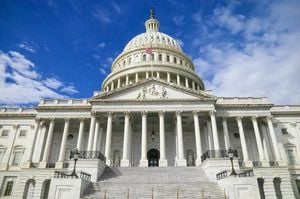On November 19, 2025, TikTok announced a sweeping set of new tools aimed at helping users spot artificial intelligence (AI)-generated videos more easily and take control over how much of this content appears in their feeds. The move, which is rolling out globally in phases over the coming weeks, reflects the growing influence of AI on social media and the urgent need for transparency as AI-made videos become increasingly difficult to distinguish from authentic footage.
TikTok's latest updates include clearer “Created with AI” labels and a more robust automatic detection system designed to flag AI-generated videos—even when creators fail to disclose their use of AI tools. According to Digital Trends, this means that the responsibility for identifying AI content no longer rests solely on creators’ honesty. Instead, TikTok’s algorithms will work behind the scenes to catch and label AI-made videos, reducing the risk that misleading or manipulated content slips through the cracks.
But TikTok isn’t stopping there. In a move that gives users more direct control, the platform is introducing a new slider in the Settings menu (under Content Preferences > Manage Topics). This slider lets users decide how much AI-generated content they encounter, whether they want their feed dominated by AI, balanced between human and machine-made, or almost entirely free of synthetic media. As Digital Trends notes, this empowers users to curate their experience according to their comfort level with AI content—a feature that’s likely to appeal to both those fascinated by AI creativity and those wary of its potential for deception.
Perhaps the most technically ambitious part of TikTok’s update is the introduction of an “invisible watermark” for AI-generated audio and video. Unlike visible tags or labels, this watermark is embedded within the content itself, making it far more difficult to remove—even if the video is edited, reposted, or otherwise manipulated. The company explained that these invisible identifiers will be applied to content made with TikTok’s own AI tools, such as AI Editor Pro, as well as to uploads that already carry C2PA (Content Credentials) metadata. This dual approach—combining visible labels with hidden, hard-to-strip watermarks—aims to make it much harder for AI-generated content to masquerade as authentic, especially as it travels across different platforms.
“Unlabeled AI clips can spread quickly and look real, especially in news-style edits, political content, and even disturbing content generated through AI apps,” Digital Trends warned. The new system is designed to address exactly this problem, providing a second, more resilient layer of verification that stays with the content no matter how many times it’s shared or altered.
For creators, these changes mean that AI-generated videos will be tagged, watermarked, and treated differently from human-made content. TikTok is urging content makers to consider how they produce and label their work, as the platform’s new detection tools will flag AI use regardless of whether it’s voluntarily disclosed.
In addition to technical updates, TikTok is putting its money where its mouth is by launching a $2 million AI-literacy fund. The goal: support educational content about responsible and transparent AI use. This initiative is designed to help users, especially younger ones, understand the implications of AI on their feeds and the broader information ecosystem. With AI-generated content playing an ever-larger role in shaping public opinion—sometimes for better, sometimes for worse—TikTok’s investment in digital literacy aims to ensure that users are equipped to navigate an increasingly synthetic media landscape.
TikTok’s emphasis on AI transparency comes at a time when the platform itself is being recognized as a major driver of brand growth. According to a November 19, 2025 interview published by PRNEWS with Bobby Blanchard, Senior Director of Audience Development at Morning Consult, TikTok and AI were highlighted as significant factors fueling the fastest growing brands in 2025. The Fastest Growing Brands report for 2025, discussed in the interview, underscores TikTok’s outsized influence on Gen Z and traditional media consumption, as well as the challenges and opportunities for earned media in the era of AI.
Blanchard’s insights shed light on why TikTok’s efforts to police AI content are so consequential. As the platform’s reach continues to expand—especially among Gen Z, who are often the first to adopt new technologies—its approach to AI transparency could set the tone for the entire social media industry. “TikTok made a big impact on this year’s growing brands,” Blanchard said, highlighting the symbiotic relationship between platform innovation and brand success.
One of the most pressing concerns driving TikTok’s new measures is the ease with which AI-generated content can be manipulated and spread. The current C2PA Content Credentials, which aim to certify the origin of digital content, can be stripped during reposts, leaving AI videos unmarked as they circulate. TikTok’s invisible watermarking technology is a direct response to this vulnerability, ensuring that AI content remains identifiable even if someone tries to remove visible tags or metadata.
The updates are rolling out in stages, with the clearer labels and improved detection system set to appear first, followed by the user controls. TikTok says that as more apps adopt Content Credentials, labeling should become more consistent across the internet—not just on its own platform. This is particularly important as AI-generated videos become common not just on TikTok, but across all major social media channels.
For everyday users, these changes will be felt almost immediately. If you scroll TikTok daily, you’ll soon notice that AI-generated content is more clearly flagged, and you’ll have unprecedented control over how much of it appears in your feed. For those who prefer a feed full of human creativity, the new slider offers a way to minimize AI content. For others who are curious about what AI can do, it’s now easier than ever to seek out synthetic videos without worrying about being misled.
For brands and communicators, the shift signals a new era of accountability and opportunity. With TikTok and AI driving brand growth, companies will need to adapt to a landscape where transparency and authenticity are paramount. As Blanchard’s interview in PRNEWS made clear, understanding how Gen Z consumes media—and how AI shapes their perceptions—will be key to success in 2025 and beyond.
In the end, TikTok’s raft of new tools reflects a broader reckoning with the power and perils of AI-generated media. By giving users more control, equipping creators with clear guidelines, and investing in digital literacy, TikTok is betting that transparency and trust will be the keys to thriving in an age of synthetic content. The coming weeks will reveal just how ready users are to take the reins—and how other platforms might follow suit.




